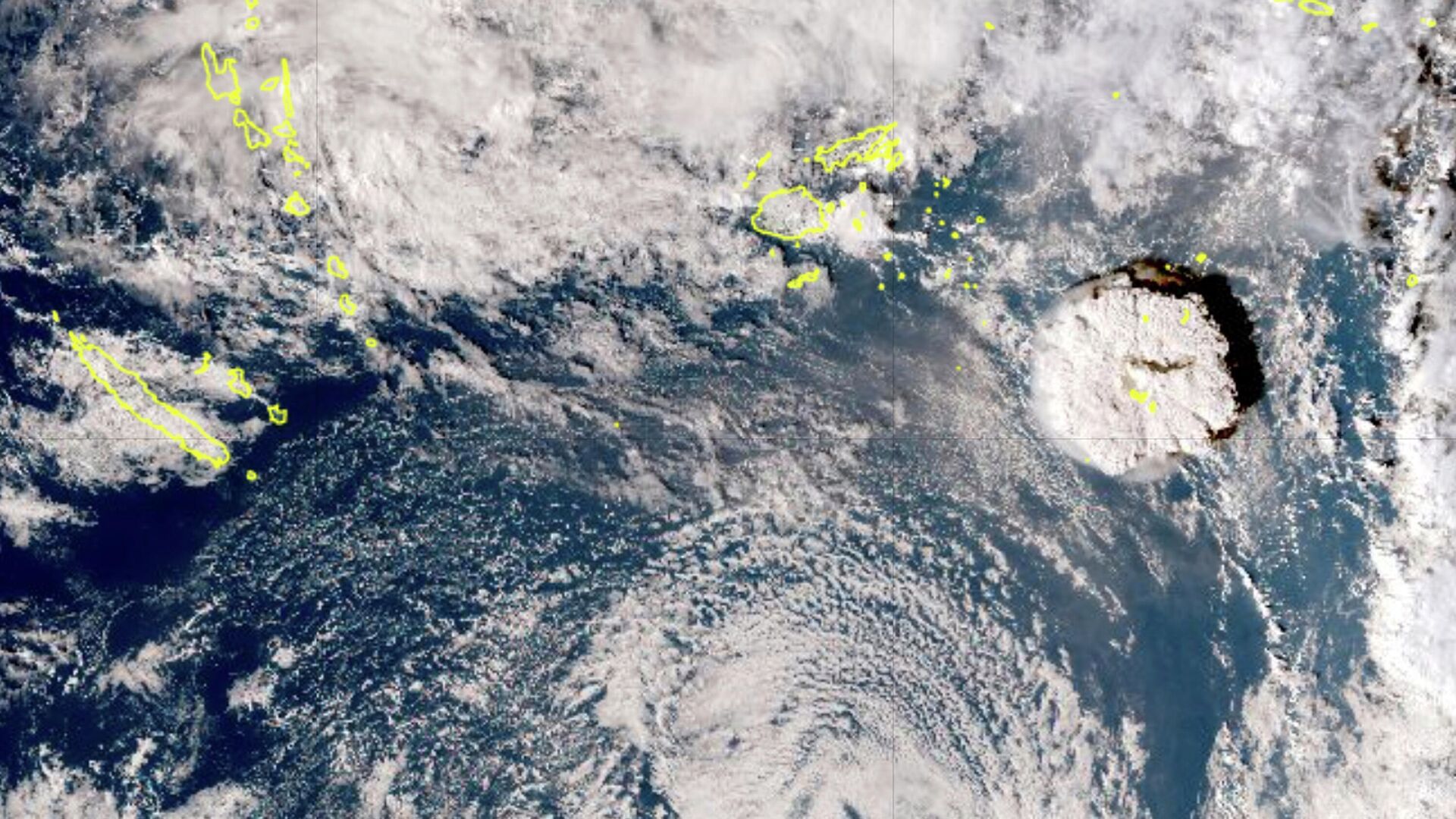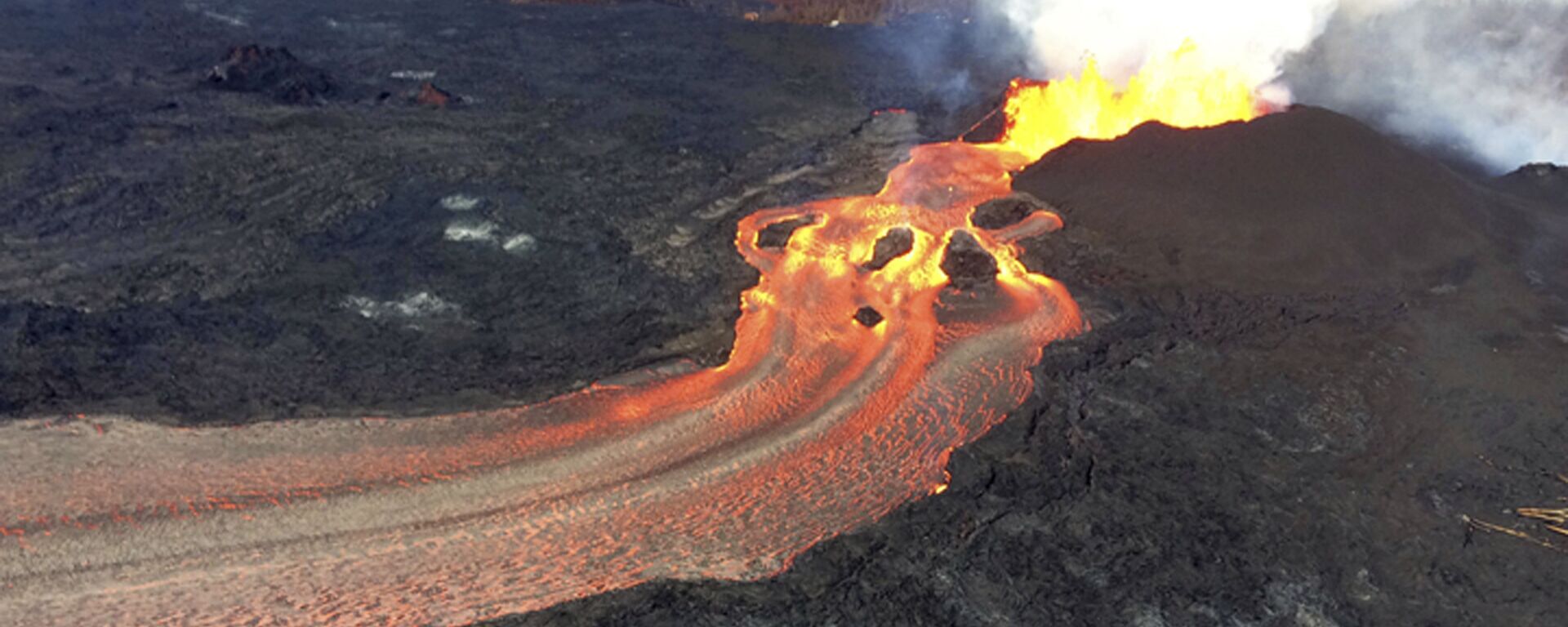https://sputnikglobe.com/20220715/study-probes-unique-nature-of-devastating-volcanic-eruption-that-sent-gravity-waves-into-ionosphere-1097363826.html
Study Probes Unique Nature of Devastating Volcanic Eruption That Sent Gravity Waves Into Ionosphere
Study Probes Unique Nature of Devastating Volcanic Eruption That Sent Gravity Waves Into Ionosphere
Sputnik International
The lead author of a study on the Hunga Tonga–Hunga Ha'apai volcano eruption argues that the data they managed to collect on it “will enhance our understanding... 15.07.2022, Sputnik International
2022-07-15T19:04+0000
2022-07-15T19:04+0000
2022-07-15T19:04+0000
volcano
eruption
https://cdn1.img.sputnikglobe.com/img/07e6/01/0f/1092281169_0:70:3000:1758_1920x0_80_0_0_c385ea247e9df099931b1ed91bc1e3f1.jpg
A new study suggests that the explosive volcanic eruption that rocked the Southern Pacific in January was so powerful that the atmospheric gravity waves it produced reached the highest layers of Earth’s atmosphere.The Hunga Tonga–Hunga Ha'apai underwater volcano erupted on January 15, producing a plume of ash that rose about 50 kilometers above the surface, and caused atmospheric gravity waves that reached 100 kilometers into the ionosphere, SciTechDaily notes.The study, published in the journal Nature and led by researchers from the University of Bath, suggests that the eruption was unique, as “gravity waves at sub-ionospheric heights have not previously been observed propagating” at the speed observed in this case.He described the eruption as “an amazing natural experiment,” noting that the data they managed to collect on it “will enhance our understanding of our atmosphere and will help us improve our weather and climate models.”Dr. Scott Osprey from the National Center for Atmospheric Science, co-author of the study, also said that their work “nicely shows how the striking display of global waves is driven by the huge amounts of seawater vaporized during the eruption.”“However, my gut feeling is that there is more to come from this eruption,” he remarked. “As the exceptional amount of water vapor spreads throughout the stratosphere, eyes will turn to the Antarctic ozone hole and just how severe it will be in the spring.”
https://sputnikglobe.com/20220530/scientists-discover-birthplace-of-worlds-most-active-volcano--1095884278.html
Sputnik International
feedback@sputniknews.com
+74956456601
MIA „Rossiya Segodnya“
2022
Sputnik International
feedback@sputniknews.com
+74956456601
MIA „Rossiya Segodnya“
News
en_EN
Sputnik International
feedback@sputniknews.com
+74956456601
MIA „Rossiya Segodnya“
Sputnik International
feedback@sputniknews.com
+74956456601
MIA „Rossiya Segodnya“
volcano, eruption
Study Probes Unique Nature of Devastating Volcanic Eruption That Sent Gravity Waves Into Ionosphere
The lead author of a study on the Hunga Tonga–Hunga Ha'apai volcano eruption argues that the data they managed to collect on it “will enhance our understanding of our atmosphere and will help us improve our weather and climate models.”
A new study suggests that the explosive volcanic eruption that rocked the Southern Pacific in January was so powerful that the atmospheric gravity waves it produced reached the highest layers of Earth’s atmosphere.
The Hunga Tonga–Hunga Ha'apai underwater volcano erupted on January 15, producing a plume of ash that rose about 50 kilometers above the surface, and caused atmospheric gravity waves that reached 100 kilometers into the ionosphere, SciTechDaily notes.
The study, published in the journal Nature and led by researchers from the University of Bath, suggests that the eruption was unique, as “gravity waves at sub-ionospheric heights have not previously been observed propagating” at the speed observed in this case.
“This was a genuinely huge explosion, and truly unique in terms of what’s been observed by science to date,” said Dr. Corwin Wright, a Royal Society University research fellow based at the Center for Space, Atmospheric and Oceanic Science at the University of Bath and lead author of the study. “We’ve never seen atmospheric waves going round the whole world before, or at this speed — they were traveling very close to the theoretical limit.”
He described the eruption as “an amazing natural experiment,” noting that the data they managed to collect on it “will enhance our understanding of our atmosphere and will help us improve our weather and climate models.”
Dr. Scott Osprey from the National Center for Atmospheric Science, co-author of the study, also said that their work “nicely shows how the striking display of global waves is driven by the huge amounts of seawater vaporized during the eruption.”
“However, my gut feeling is that there is more to come from this eruption,” he remarked. “As the exceptional amount of water vapor spreads throughout the stratosphere, eyes will turn to the Antarctic ozone hole and just how severe it will be in the spring.”


